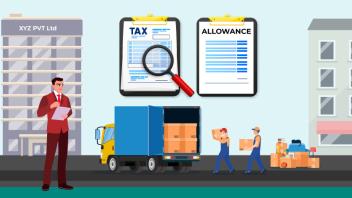Effective Upsell and Cross-Sell Strategy in the Moving Industry

Upselling and cross-selling are pivotal strategies that, when executed well, can significantly enhance revenue streams and strengthen customer relationships.
Upselling involves encouraging customers to purchase a higher-end version of what they originally planned to buy, while cross-selling invites them to buy related or complementary services. For instance, upselling can involve offering premium packing materials instead of standard ones, and cross-selling might involve suggesting temporary storage solutions alongside the moving service.
Understanding Upselling and Cross-Selling in Moving Industry
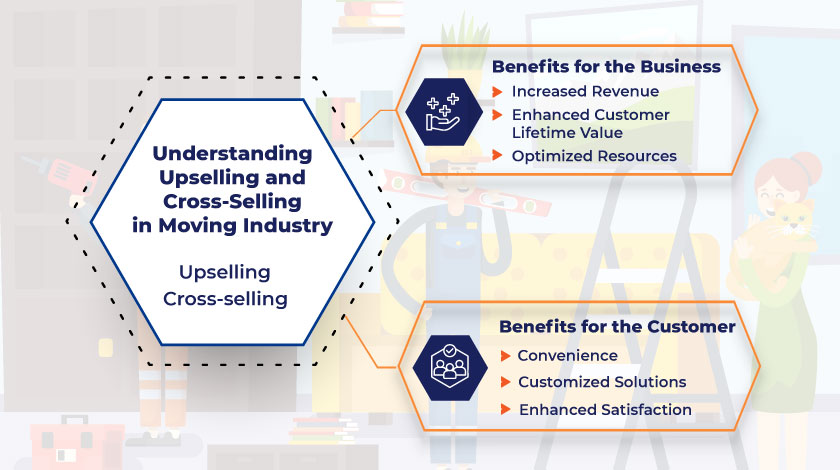
In the dynamic field of moving services, mastering the techniques of upselling and cross-selling can be the difference between a basic service offering and a comprehensive solution that significantly enhances customer satisfaction and company revenue.
- Upselling is the practice of encouraging customers to purchase a higher-end version of the service or product they initially considered. For a moving company, this could mean suggesting a full-service pack and move option rather than just the basic moving service. For example, if a customer initially inquires about standard moving services, you might upsell them on a premium package that includes detailed item handling and specialized packing for fragile items like artwork or electronics.
- Cross-selling involves recommending additional, complementary services that enhance the main service being purchased. In the moving industry, this could involve offering temporary storage solutions if the customer's new home is not ready by the move-out date, or suggesting professional cleaning services for the house they are leaving and the one they are moving into. Another common cross-sell is offering to supply packing materials or providing handyman services to help with tasks such as furniture assembly or installation needs at the new location.
Benefits for the Business
- Increased Revenue: Upselling and cross-selling can substantially increase the average transaction size, directly impacting the bottom line. By selling more services or premium packages, your business can generate more revenue from the same number of transactions.
- Enhanced Customer Lifetime Value: Customers who experience the full range of your services are more likely to return and recommend your business to others. This increases the lifetime value of each customer through repeat business and referrals.
- Optimized Resources: By offering more services per customer, you can better utilize your staff and resources, potentially reducing downtime and increasing efficiency.
Benefits for the Customer
- Convenience: Upselling and cross-selling make the moving process more convenient for customers. By offering comprehensive packages, customers can get all their needs met through a single provider instead of coordinating multiple services from different companies.
- Customized Solutions: These strategies allow customers to tailor services precisely to their needs, whether they’re looking for budget-friendly options or comprehensive, hassle-free moving solutions.
- Enhanced Satisfaction: Customers who take advantage of upsells or cross-sells often have a better overall experience, as they are getting more value and better service, tailored to their specific requirements. This leads to higher satisfaction and loyalty.
Strategic Implementation of Upselling
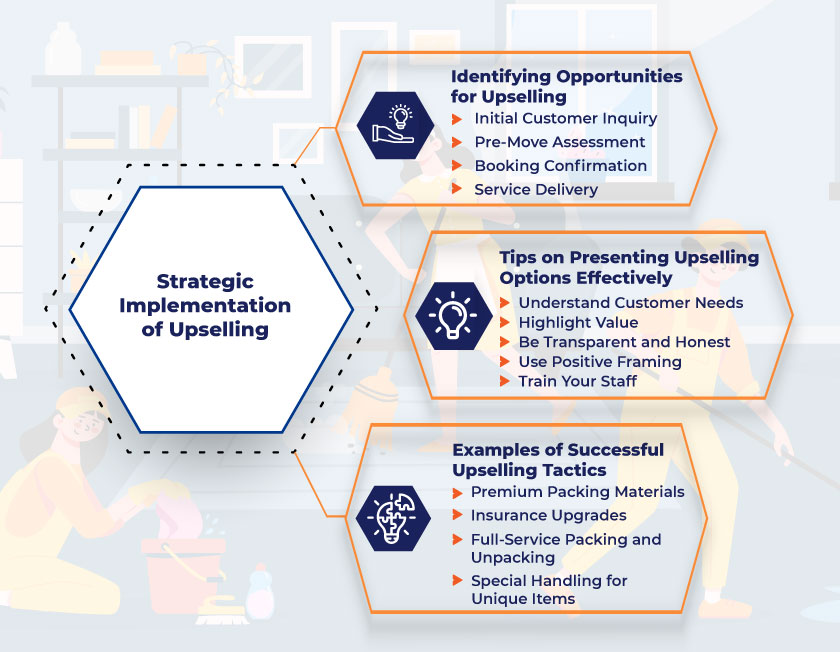
Upselling is a powerful strategy to increase revenue and enhance the customer experience during the moving process. By identifying key opportunities and presenting upselling options effectively, moving companies can provide greater value and ensure customers receive the best possible service.
Identifying Opportunities for Upselling
- Initial Customer Inquiry: This is the prime moment to introduce higher-tier service packages. Listen carefully to the customer’s needs and preferences to recommend appropriate upgrades.
- Pre-Move Assessment: During the inventory or assessment visit, identify items that may require special handling or packing and suggest appropriate upgrades.
- Booking Confirmation: When a customer confirms a booking, it's an opportunity to review the service plan and suggest additional options they might not have considered.
- Service Delivery: Even on the moving day, there may be last-minute opportunities to suggest additional services based on observed needs.
Tips on Presenting Upselling Options Effectively
- Understand Customer Needs: Tailor your upsell recommendations to address the specific challenges or needs expressed by the customer. This personal touch makes the upsell seem less like a sales pitch and more like a thoughtful solution to their problems.
- Highlight Value: Emphasize the benefits and value of the upsell option. Explain how it can save time, reduce stress, or provide peace of mind during the move.
- Be Transparent and Honest: Always be clear about the costs and benefits. Honesty builds trust, which is crucial for encouraging customers to consider and accept an upsell.
- Use Positive Framing: Present upsells as opportunities for enhancing the moving experience rather than merely additional costs.
- Train Your Staff: Ensure that all team members understand the upsell options available and how to present them effectively. This includes not just sales staff but also movers who might spot opportunities on the moving day.
Examples of Successful Upselling Tactics
- Premium Packing Materials: Offer options for higher-quality or specialized packing materials that offer better protection than standard materials. For example, suggest using custom crates for artwork or electronic equipment, which can reassure customers that their valuable items are well-protected.
- Insurance Upgrades: While basic coverage might be included, offering enhanced insurance options provides customers with extra security for their valuable possessions. Explain the different levels of coverage available and how they might be beneficial depending on the inventory.
- Full-Service Packing and Unpacking: Instead of basic moving services, propose a full-service package that includes not just moving but also complete packing and unpacking services. Highlight how this service can significantly reduce the workload and stress for the customer.
- Special Handling for Unique Items: If the customer has pianos, antiques, or other specialty items, suggest your specialized handling services that are designed for such items. Emphasize the expertise and care that will be provided to ensure these items are moved safely.
Read: How to Provide Safe and Secure Transport to Your Customers
Effective Cross-Selling Techniques
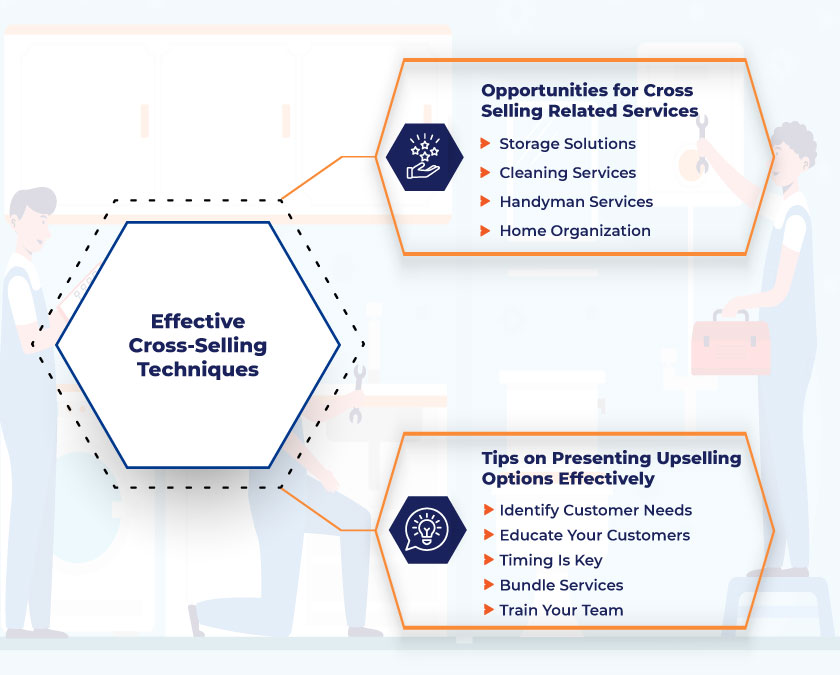
Cross-selling in the moving industry involves offering additional, complementary services that enhance the main moving service, thereby creating a more comprehensive solution for customers. This approach not only increases revenue but also boosts customer satisfaction by providing a more complete moving experience.
Opportunities for Cross-Selling Related Services
- Storage Solutions: Offer short-term or long-term storage services for clients who cannot immediately move into their new homes or need extra space. This is particularly useful for customers downsizing or those in transitional phases.
- Cleaning Services: Suggest post-move cleaning for the property they are leaving and/or the one they are moving into. This is a valuable service for customers looking to secure their deposit back on rentals or to ensure their new home is ready for occupancy.
- Handyman Services: Recommend installation services for appliances, electronics, or furniture assembly in the new home. Many customers appreciate the convenience of moving in with everything set up.
- Home Organization: Offer professional organizing services to help customers settle into their new homes quicker. This can include unpacking and arranging items in kitchens, closets, and storage areas.
Best Practices for Integrating Cross-Selling into Sales Conversations
- Identify Customer Needs: Engage in detailed conversations to understand the full scope of the customer’s moving situation. This understanding will allow you to appropriately suggest additional services that meet their specific needs.
- Educate Your Customers: Sometimes customers are not aware of all the services you offer. Take the opportunity to inform them about how these services can simplify and enhance their moving experience.
- Timing Is Key: Introduce cross-sell options at strategic points, such as after booking the moving date when the customer is thinking about the next steps, or during the follow-up call a few days before the move.
- Bundle Services: Create packages that bundle moving services with one or more additional services at a discounted rate compared to purchasing each service separately. This makes the offer more attractive.
- Train Your Team: Train your employee to ensure that all team members are knowledgeable about all services and confident in explaining their benefits. This includes not only sales staff but also movers who might identify needs on moving day.
Training Your Team for Success
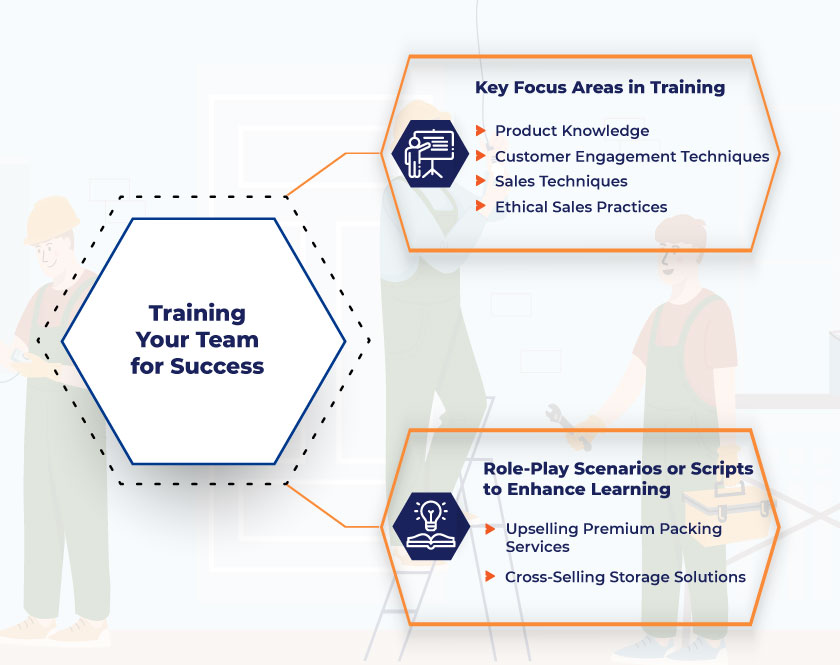
Proper training of moving consultants and customer service representatives is crucial to the success of any upselling and cross-selling initiatives within the moving industry. Well-trained employees not only drive sales but also enhance customer satisfaction and loyalty by delivering informed, respectful service.
Key Focus Areas in Training
Training equips your team with the necessary skills and confidence to effectively interact with customers, making them feel valued and understood. A knowledgeable team can identify customer needs and tailor services to those needs, which results in more successful sales and enhanced customer experiences.
- Product Knowledge: Thorough knowledge of all services offered is essential. Team members should understand the features, benefits, and potential drawbacks of each service to advise customers appropriately.
- Customer Engagement Techniques: Training should include how to listen actively, ask the right questions, and read customer cues. This understanding helps tailor conversations to highlight the most relevant services.
- Sales Techniques: Focus on the principles of effective selling, including how to introduce upsell and cross-sell suggestions naturally during conversations and how to handle objections gracefully.
- Ethical Sales Practices: Ensure that all team members are aware of the importance of honesty and integrity in sales. Customers should feel that they are being offered value, not just being sold to.
Role-Play Scenarios or Scripts to Enhance Learning
Role-playing is a dynamic and practical method of training that helps team members practice and refine their skills. Here are a couple of scenarios and scripts that could be useful:
Scenario 1: Upselling Premium Packing Services
- Customer: “I think I’ll go with your basic moving package.”
- Consultant: “That’s a great choice to get everything you need moved efficiently. Based on the items you mentioned, like your electronics and art collection, I would recommend considering our premium packing services. These include specialty materials that protect fragile items and ensure they arrive safely. Many of our clients find this provides peace of mind during the move. Would you like to hear more about these options?”
Scenario 2: Cross-Selling Storage Solutions
- Customer: “I’m not sure what to do. I have to vacate my current home before the new one is ready.”
- Consultant: “I understand that timing can be challenging. We offer convenient storage solutions that could be perfect for your situation. We can store your belongings securely until your new home is ready. Many customers find this service removes a lot of the stress from the moving process. Shall I include this in your quote so you can see how it works?”
Handling Objections and Building Trust
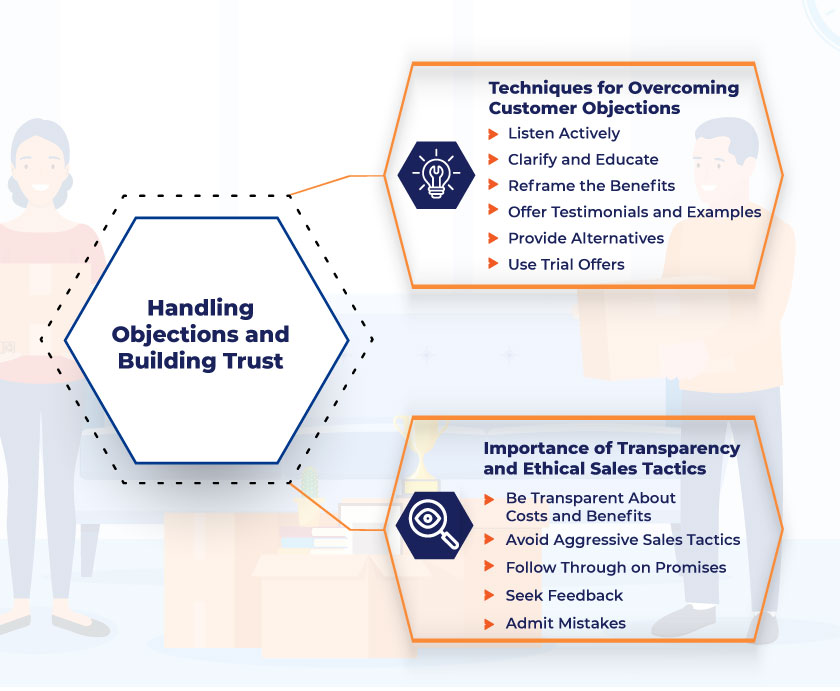
When upselling and cross-selling, encountering objections is common. However, how these objections are handled can significantly influence customer trust and the overall relationship. In the following discussion, we examine strategies for successfully addressing concerns and highlight the significance of transparency and ethical sales methods in establishing enduring client connections.
Techniques for Overcoming Customer Objections
- Listen Actively: Before responding to objections, it’s crucial to listen carefully and understand the customer’s concerns. Acknowledge their points and show empathy to build a rapport and demonstrate that their satisfaction is your priority.
- Clarify and Educate: Sometimes objections arise from misunderstandings about the value or applicability of a service. Clarify any misconceptions and educate the customer on how the suggested service can specifically address their needs or enhance their experience.
- Reframe the Benefits: If customers are hesitant, reframe the benefits of the service in a way that aligns with their goals or concerns. For example, if a customer is worried about the cost of premium packing materials, highlight the cost-effectiveness in the long run due to better protection and lower risk of damage.
- Offer Testimonials and Examples: Share stories or testimonials from other customers who benefited from the additional services. This can help reduce apprehension by showing proven outcomes.
- Provide Alternatives: If resistance persists, offer scaled-down versions of the service or different package options that might be more within their comfort zone but still offer added value compared to the basic offering.
- Use Trial Offers: Consider providing a trial or a demo of the service if applicable, which can alleviate fears by letting customers experience the benefits firsthand without a full commitment.
Importance of Transparency and Ethical Sales Tactics
- Be Transparent About Costs and Benefits: Always be upfront about the costs associated with any upsells or cross-sells. Explain what the customer will receive in return, ensuring they understand the value proposition.
- Avoid Aggressive Sales Tactics: Pushing customers too hard can lead to dissatisfaction and distrust. Focus on being helpful rather than just achieving a sale. If a customer decides against an upsell or cross-sell, respect their decision.
- Follow Through on Promises: Ensure that any claims made during the sales process are fulfilled. This consistency between what is sold and what is delivered is crucial in building credibility and trust.
- Seek Feedback: Actively ask for feedback on the services provided, including upsells and cross-sells. This not only shows customers that their opinion is valued but also helps you improve service offerings.
- Admit Mistakes: If something goes wrong, admit it and take action to rectify the situation. This honesty in handling mistakes can strengthen trust more than flawless service.
Elevate Your Moving Services with Smart Selling
In this blog, we have explored the nuanced strategies of upselling and cross-selling within the moving industry, emphasizing how these techniques can significantly enhance both revenue and customer satisfaction.
Further, we delved into training teams for success, ensuring that staff are well-prepared to execute these strategies with confidence and integrity. Handling objections and building trust were also covered, underlining the importance of transparency and ethical practices in fostering long-term customer relationships.
We encourage you to implement these strategies in your business. By doing so, you can not only increase your revenue but also significantly enhance the moving experience for your customers, leading to higher satisfaction and loyalty. Remember, the goal is to provide value that resonates with your customers' needs and expectations.










